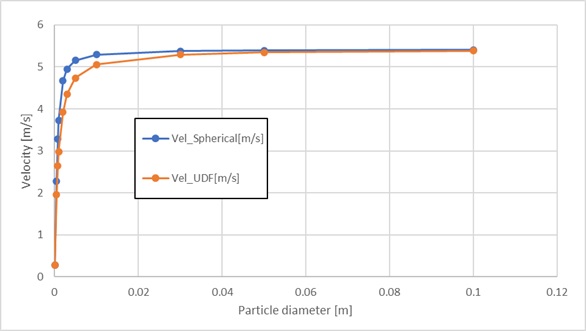 |
|
|
[Sponsors] | |||||
|
|
|
#1 |
|
Member
Join Date: Jul 2013
Posts: 98
Rep Power: 13  |
Hello,
I am trying to get an udf working for a modified particle drag. As a testing experiment, I am running some simulations trying to mimick the Morsi-Alexander Drag Law with an UDF. Running the test case, where I simply have a straight pipe with the default Fluent code and with my UDF, I am not getting the same values, and I don't really know why... The code I have used is below. At this thread they claim that it works, but I don't really know how they managed... The deviation I get from using the UDF or the Fluent embedded code is shown in the figure:  Any ideas?? Thanks and regards. Code:
#include "udf.h"
DEFINE_DPM_DRAG(particle_drag_force, Re, p)
{
real drag_force;
real w;
w=18*Re/24;
if (Re < 0.01)
{
drag_force=18;
return (drag_force);
}
else if (0.1 < Re < 1)
{
drag_force = (22.73/Re+0.0903/pow(Re,2)+3.69)*w;
return (drag_force);
}
else if (1 < Re < 10)
{
drag_force = (29.1667/Re-3.8889/pow(Re,2)+1.222)*w;
return (drag_force);
}
else if (10 < Re < 100)
{
drag_force = (46.5/Re-116.67/pow(Re,2)+0.6167)*w;
return (drag_force);
}
else if (100 < Re < 1000)
{
drag_force = (98.33/Re-2778/pow(Re,2)+0.3644)*w;
return (drag_force);
}
else if (1000 < Re < 5000)
{
drag_force = (148.62/Re-47500/pow(Re,2)+0.357)*w;
return (drag_force);
}
else if (5000 < Re < 10000)
{
drag_force = (-490.546/Re-578700/pow(Re,2)+0.46)*w;
return (drag_force);
}
else
{
drag_force = (-1662.5/Re+5.4167*pow(10,6)/pow(Re,2)+0.5191)*w;
return (drag_force);
}
}
|
|
|
|

|
|
|
|
|
#2 |
|
New Member
Join Date: May 2023
Posts: 1
Rep Power: 0  |
Did you find a solution? I have similar code and the results are about the same for some particle sizes but quite off for others
|
|
|
|

|
|
|
|
|
#3 |
|
Member
Join Date: Jul 2013
Posts: 98
Rep Power: 13  |
Unfortunately did not, sorry.
|
|
|
|

|
|
 |
| Tags |
| drag law, fluent - udf, morsi |
|
|
 Similar Threads
Similar Threads
|
||||
| Thread | Thread Starter | Forum | Replies | Last Post |
| Induced drag, pressure drag, viscous drag. | aleix.de.toro | FLUENT | 2 | August 24, 2015 19:00 |
| UDF for modified drag force | burak_ekmekci | Fluent UDF and Scheme Programming | 1 | May 17, 2015 10:16 |
| udf for drag model in 3D spouted bed | mohsen0488 | Fluent UDF and Scheme Programming | 0 | November 5, 2014 05:52 |
| Low Reynolds Number Drag Law - UDF | Daggemann | FLUENT | 0 | April 30, 2009 06:02 |
| multiphase model and drag law | Yasmail AKARIOUH | FLUENT | 0 | April 29, 2008 08:44 |